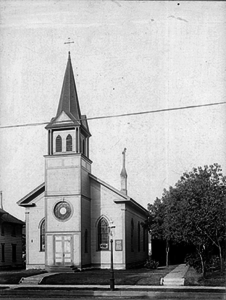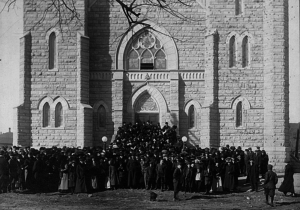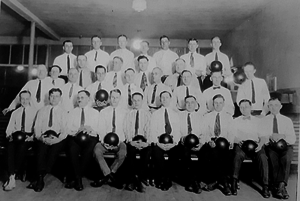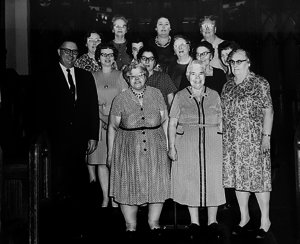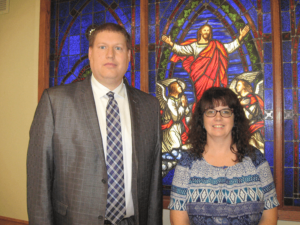A small group of German immigrants gathered in a Northeast Minneapolis school building at 14th avenue and Main Street on October 13, 1867, to form a new Lutheran church. They named it Evangelische Lutheranische St. Johannes Kirche of St. Anthony. Reverend George Fachtmann was the founding pastor.
That early church has survived in Northeast for 150 years. Now known as St. John’s Evangelical Lutheran Church, its members dedicated their present building, a large Gothic structure at Broadway and Washington streets NE, in 1911. The congregation will celebrate its anniversary with events October 13 through 15.
Early history
In 1867, there were 65 people in the congregation when Rev. Leonard Frey was installed as the first resident pastor. Although he served for only four years, the church’s history records show that they were busy ones, especially 1869, when the church bought land at 625 Main St. NE, and built a frame church that could seat 165 people, a school house, and a parsonage.
In 1870, Frey presided over 39 baptisms, 15 confirmations, three marriages, and two burials. The Synod Treasury had $1.20 in its coffers and the Widows Fund had $1.25. After Frey relocated to a church in Lewiston, Minn. in 1872, several “vacancy” pastors filled in, including Friedrich Herzer, J. Kogler and Immanuel Achilles. Unfortunately, when Achilles’ house in St. Paul caught fire in 1881, St. John’s records from 1867 through 1881 were lost.
The second resident pastor, installed in 1881, likely holds the record for the longest name ever: Rev. Ernst Heinrich August Johannes Margott Helidor Quehl. The congregation paid $1041.50 to enlarge the church with a vestibule, belfry and steeple on one end and a sanctuary on the other.
The year 1904 was notable because it marked Rev. Paul Dowidat’s installation as pastor. Dowidat, who retired in 1962, had the longest tenure in the church’s 150-year history. Under his leadership, the congregation organized a building committee that bought land (church records described the price as “for a trifle over $1300”) from the Chute Brothers, at the corner of Broadway and Washington streets NE.
In 1910, St. John’s sold its 625 Main St. property to Our Lady of Mt. Carmel Church for $5,500 and started building its new Gothic style church. Constructed from colfax stone, it cost $22,950. The Young People’s Society bought glass for the windows and the Ladies Aid Society pledged that it would buy a pipe organ.
The ladies hit a snag in their fundraising, however, and found themselves $1,000 short. Pastor Dowidat, fearing that his beautiful new church would have no organ, took a chance. He wrote a letter to philanthropist Andrew Carnegie explaining St. John’s predicament. (Carnegie, he remembered, had once been described in a magazine story as a person who loved church music.) A few days later, Carnegie sent a check for $1,000, and the church was dedicated on Feb. 26, 1911.
Clubs, war, renovation, war
The St. John’s Men’s Club originated in May, 1912, and the choir formed that November. The Bowling Club started in 1914. The church had 700 members.
At this time, things were changing quickly in the United States and the world. The church discontinued its German school, and 14 St. John’s members were drafted into the Armed Forces for World War I, known as The Great War.
The church underwent extensive remodeling in 1938, which included adding two new club rooms, a choir loft, and an enlarged kitchen, stage and study. Church members attended church at nearby Sheridan School while their building was under construction. The project cost $85,000.
In 1943, the world again was at war: 102 men from St. John’s joined the Armed Forces during World War II. That same year, the church disbanded its Men’s Club.
100 years, a new school, two new pastors
In 1956, Assistant Pastor Willard Kehrberg was installed. After Pastor Dowidat retired, Rev. Donald Grummert became the pastor in 1963. The church celebrated its 100th anniversary over three Sundays in October, 1967.
St. John’s congregation decided to open a Christian Day School at the church. It opened in the church basement on Sept. 3, 1975, with 23 students. Nancy Ehlert was the first teacher. (The school lasted nearly 30 years; it closed in 2004. A preschool, CrossWalk, opened in 2006 and closed in 2009.)
Rev. William Schaefer took over as St. John’s pastor in 1985, after Rev. Grummert retired.
In 1990, the church kitchen was refurbished and the congregation approved a $69,000 renovation project that included cleaning up the exterior stone, replacing the front steps and refurbishing the church’s 17 gorgeous stained glass windows. New windows (29 bronze aluminum combinations) and ventilators were also part of the project. The following year, workers added two permanent classrooms and a new Fellowship Hall on the lower level. The project cost $12,000.
Today’s church
Rev. Daniel Lindner came to St. John’s Evangelical Lutheran Church in 2006. A Northeast resident, he is originally from Wisconsin. St. John’s belongs to the Wisconsin Evangelical Lutheran Synod, he said, adding, “We are the third largest Lutheran Synod in the United States.
Lindner said he enjoys Northeast Minneapolis for its diversity, city atmosphere, social activities, and spirit of volunteerism. “Our church has had its ups and downs in its 150 year history, but the Lord has blessed us enough to still be here,” he said.
The building has no air conditioning. Its boiler, which he said still works well, dates back to 1938. (In the early days, parishioners set large blocks of ice in front of the boiler’s blower to send cool air through the building.) When the church added an elevator, one of the stained glass windows had to be relocated to the Fellowship Hall.
Lindner said the windows are very remarkable. “A beautiful time to be here is when the sun is setting.”
About 154 families comprise St. John’s congregation; about half live in Northeast. According to Lindner, that total includes “225 communicate members and 300 baptized souls.” In recent years, he has formed a campus ministry known as True North. He visits the University of Minnesota once a week and works with students. He also welcomes them to his church for activities. “We have Bible study, social gatherings. They have free access to our space; we have movie nights and game nights.” He said some of the students have become church members, while others belong to other Wisconsin Evangelical Lutheran Synod churches.
He said the outreach is going well. “A lot of kids at the University come from small towns, and find the city overwhelming.” He said St. John’s members, who tend to be older, have been welcoming to the students. “We’ve changed our operating strategies somewhat. We’ve had to merge two ministries together and go with the flow on organizing and structure.”
The 150-year anniversary celebration will include an all-school reunion at a Northeast restaurant on October 13, a True North alumni and parent reunion and 6 p.m. vesper service on October 14, and an October 15 church service at 10 a.m. with a dinner to follow. For information, contact the church, 612-379-4296, e-mail Lindner at lindnerdan@hotmail.com, or visit the church’s website, www.stjohnsmplswels.org.
Below: The original church on Main Street. The crowd at the 1911 dedication. The Men’s Bowling Team, formed in 1914 when the church had 700 members, and a women’s group, possibly from the 1960s (Photos courtesy of the church) Current pastor Daniel Lindner and Administrative Assistant Nicole Person. (Photo by Gail Olson)
